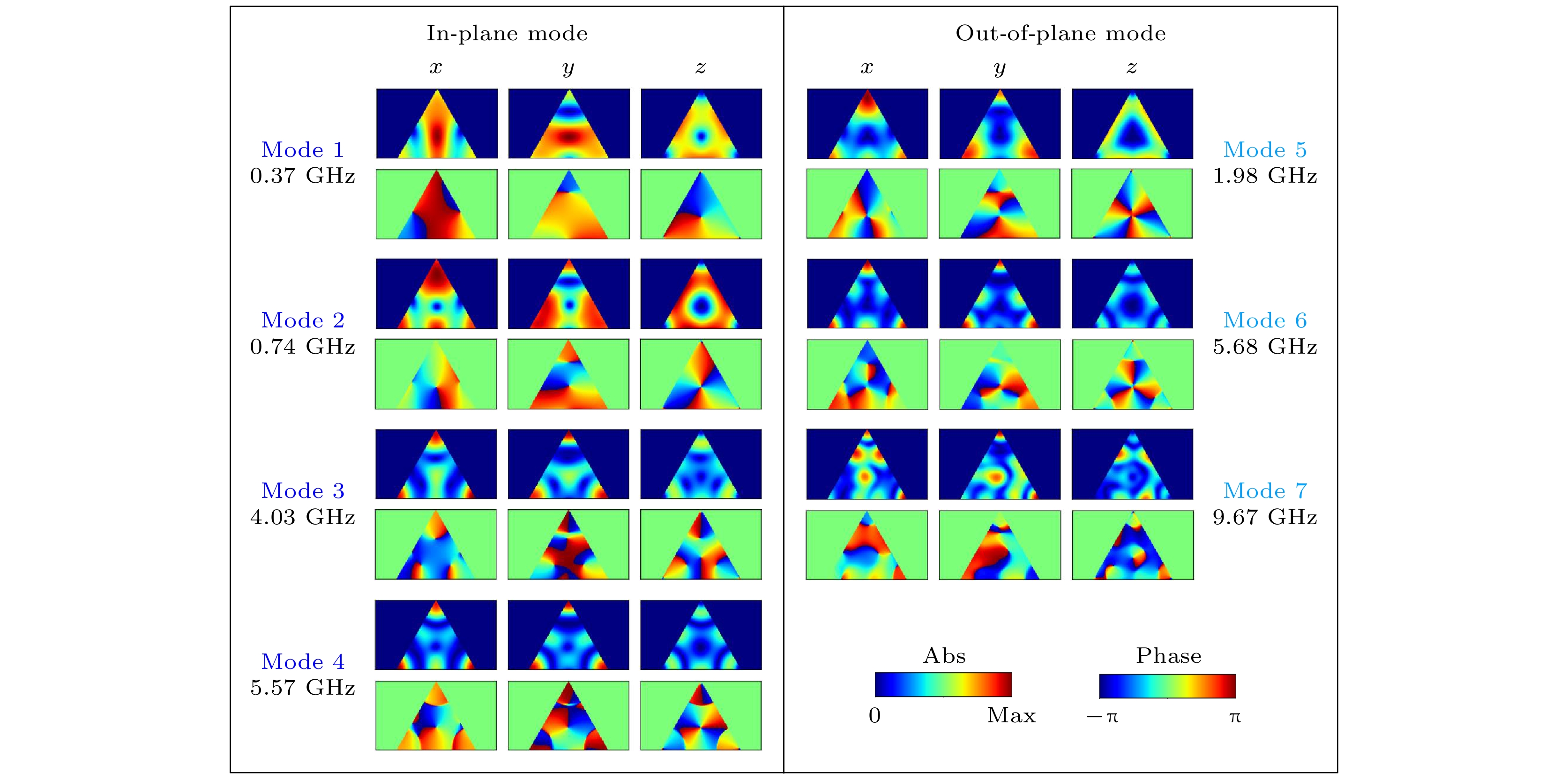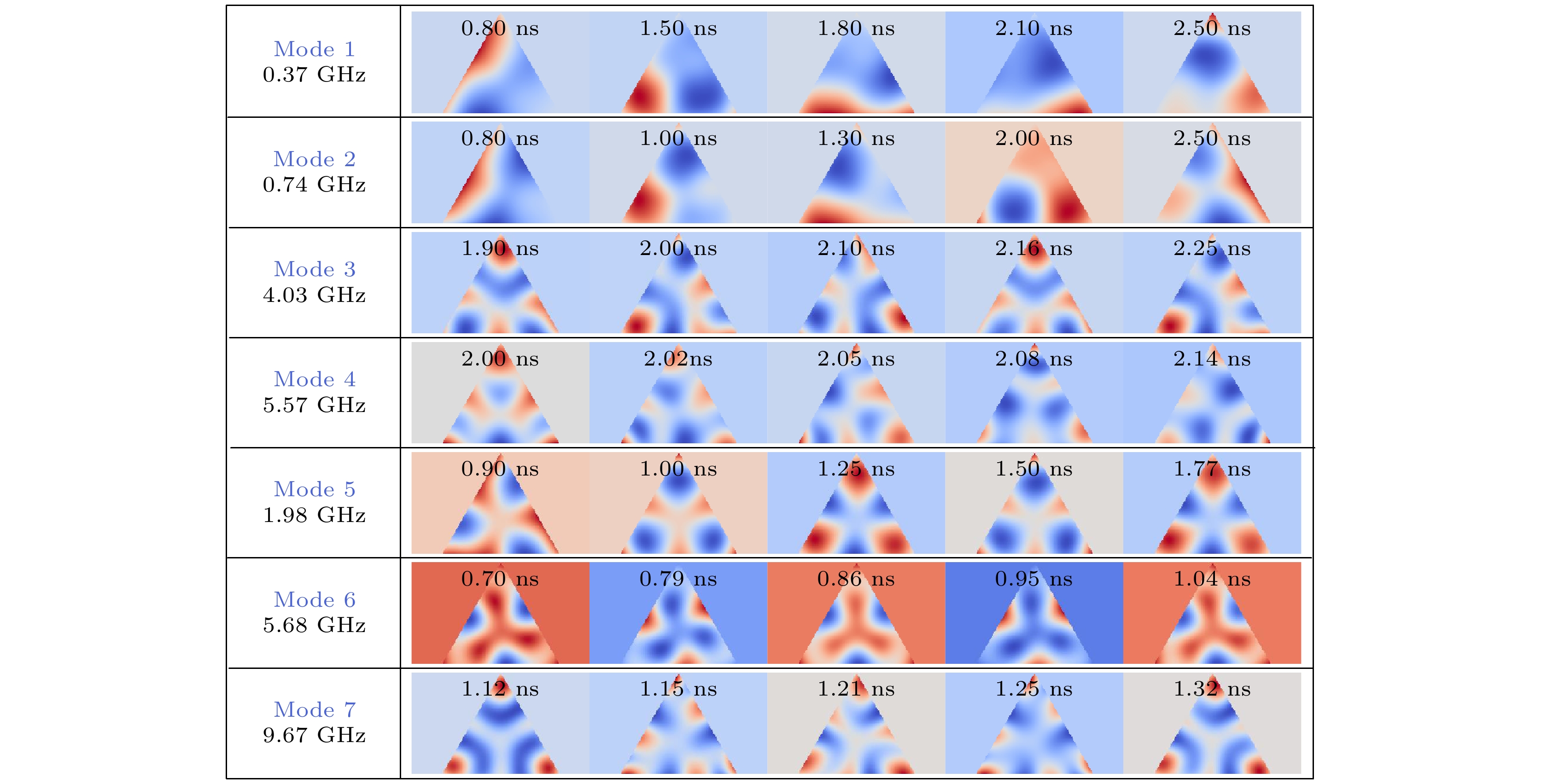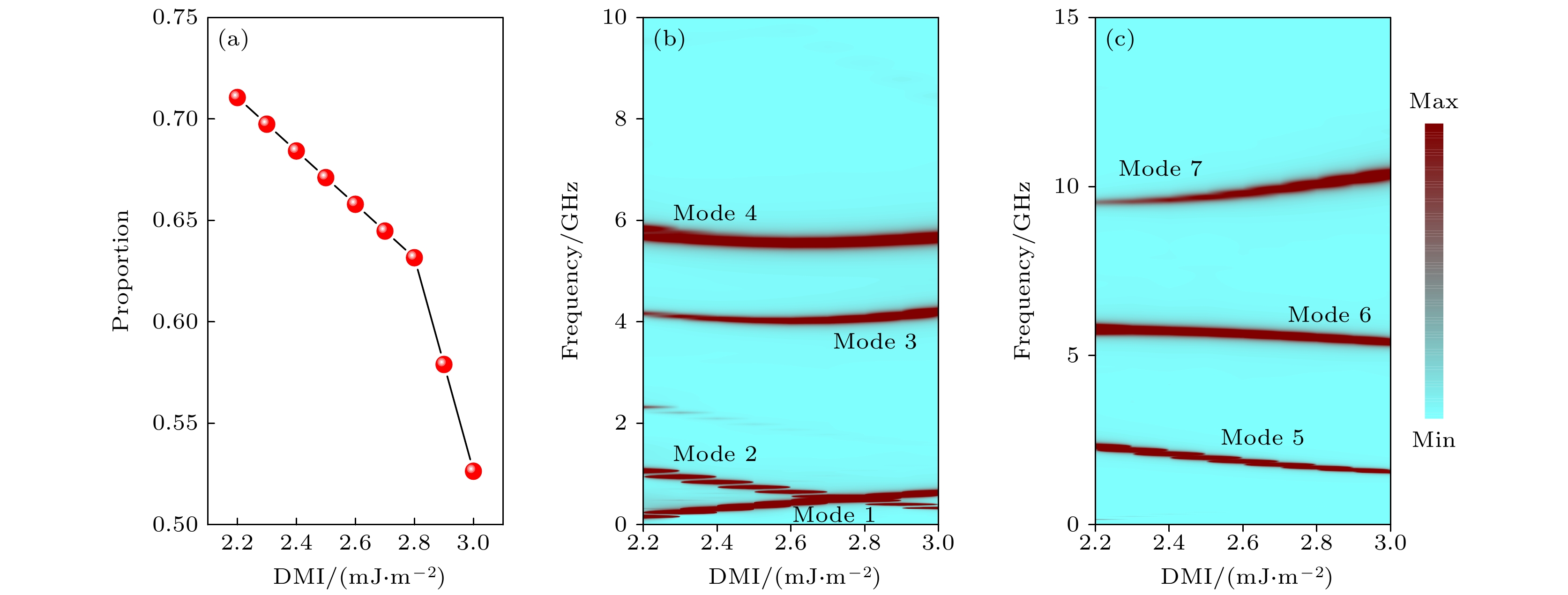-
As a kind of nanoscale magnetic structure, the magnetic vortex has the advantages of small size, easy integration, easy control, low driving current density, low heat loss, etc. Owing to its potential application value and research significance, it has received more and more attention since its discovery.The existence of the magnetic vortex is the result of the competition between the exchange energy and the magnetostatic energy in the system. The magnetization of magnetic vortex usually contains the in-plane part and the central region part, so it usually has dual properties of chirality and polarity. The chirality is related to the arrangement of the magnetization in the plane, which can be divided into clockwise direction and counterclockwise direction. Moreover, the polarities +1 and –1 respectively represent the magnetization in the central area of the magnetic vortex core along the +z axis and –z axis. On the one hand, the magnetic vortex can be used as an information carrier in the storage device by driving the polarity reversal, and has the advantages of fast reading and writing speed, easy erasing and rewriting. On the other hand, it is expected to be used in next-generation spintronic devices, such as spin nano-oscillators based on magnetic vortex, which can continuously output high-frequency microwave signals. To further enhance the applicability of magnetic vortex, the Dzyaloshinskii–Moriya interaction (DMI) is introduced into the system, with symmetry breaking or strong spin-orbit coupling, and its dynamic process can be regulated by changing the magnetic vortex structure. The DM effective field plays a role in forcing the adjacent magnetization to be along the perpendicular direction in the heterostructure system lacking interface inversion symmetry. Thus, the existence of DMI can make the in-plane magnetization oriented to the out-of-plane direction. In this work, the triangle-shape magnetic vortex structure is varied by changing the strength of DM effective field. The microwave magnetic fields are respectively applied along the in-plane direction and out-of-plane direction, and the eigenfrequencies are obtained by using fast Fourier transform. Next, we further explore the spin wave modes at different eigenfrequencies. Finally, we vary the intensity of DMI in the system to adjust different eigenfrequencies. These results open up possibilities for the development and application of magnetic vortex in spintronics.
-
Keywords:
- magnetic vortex /
- spin wave mode
[1] Vansteenkiste A, Chou K W, Weigand M, Curcic M, Sackmann V, Stoll H, Tyliszczak T, Woltersdorf G, Back C H, Schütz G, Waeyenberge B V 2009 Nat. Phys 5 332
 Google Scholar
Google Scholar
[2] Völkel A R, Wysin G M, Mertens F G, Bishop A R, Schnitzer H J 1994 Phys. Rev. B 50 12711
 Google Scholar
Google Scholar
[3] Thiele A A 1973 Phys. Rev. Lett 30 230
 Google Scholar
Google Scholar
[4] Choe S B, Acremann Y, Scholl A, Bauer A, Doran A, Stöhr J, Padmore H A 2004 Science 304 420
 Google Scholar
Google Scholar
[5] Kravchuk V P, Sheka D D, Gaididei Y, Mertens F G 2007 J. App. Phys 102 043908
 Google Scholar
Google Scholar
[6] Shinjo T, Okuno T, Hassdorf R, Shigeto K, Ono T 2000 Science 289 930
 Google Scholar
Google Scholar
[7] Wachowiak A, Wiebe J, Bode M, Pietzsch O, Morgenstern M, Wiesendanger R 2002 Science 298 577
 Google Scholar
Google Scholar
[8] Siracusano G, Tomasello R, Giordano A, Puliafito V, Azzerboni B, Ozatay O, Carpentieri M, Finocchio G 2016 Phys. Rev. Lett 117 087204
 Google Scholar
Google Scholar
[9] Huber D L 1982 J. Appl. Phys 53 1899
 Google Scholar
Google Scholar
[10] Xiao Q F, Rudge J, Choi B C, Hong Y K, Donohoe G 2006 Appl. Phys. Lett. 89 262507
 Google Scholar
Google Scholar
[11] Hertel R, Gliga S, Fahnle M, Schneider C M 2007 Phys. Rev. Lett. 98 117201
 Google Scholar
Google Scholar
[12] Weigand M, Waeyenberge B V, Vansteenkiste A, Curcic M, Sackmann V, Stoll H, Tyliszczak T, Kaznatcheev K, Bertwistle D, Woltersdorf G, Back C H, Schütz G 2009 Phys. Rev. Lett. 102 077201
 Google Scholar
Google Scholar
[13] Kim S K, Lee K S, Yu Y S, Choi Y S 2008 Appl. Phys. Lett. 92 022509
 Google Scholar
Google Scholar
[14] Bohlens S, Krüger B, Drews A, Bolte M, Meier G, Pfannkuche D 2008 Appl. Phys. Lett. 93 142508
 Google Scholar
Google Scholar
[15] Pigeau B, Loubens G d, Klein O, Riegler A, Lochner F, Schmidt G, Molenkamp L W, Tiberkevich V S, Slavin A N 2010 Appl. Phys. Lett. 96 132506
 Google Scholar
Google Scholar
[16] Yu X Z, Onose Y, Kanazawa N, Park J H, Han J H, Matsui Y, Nagaosa N, Tokura Y 2010 Nature 465 901
 Google Scholar
Google Scholar
[17] Huang S X, Chien C L 2012 Phys. Rev. Lett. 108 267201
 Google Scholar
Google Scholar
[18] Heinze S, Bergmann K v, Menzel M, Brede J, Kubetzka A, Wiesendanger R, Bihlmayer G, Blügel S 2011 Nat. Phys. 7 713
 Google Scholar
Google Scholar
[19] Dzyaloshinsky I 1958 J. Phys. Chem. Solids 4 241
 Google Scholar
Google Scholar
[20] Jaafar M, Yanes R, Asenjo A, Chubykalo-Fesenko O, Vázquez M, González E M, Vicent J L 2018 Nanotechnology 19 285717
[21] Jaafar M, Yanes R, Lara D P d, Chubykalo-Fesenko O, Asenjo A, Gonzalez E M, Anguita J V, Vazquez M, Vicent J L 2010 Phys. Rev. B 81 054439
 Google Scholar
Google Scholar
[22] Lin C S, Lim H S, Wang C C, Adeyeye A O, Wang Z K, Ng S C, Kuok M H 2010 J. Appl. Phys 108 114305
 Google Scholar
Google Scholar
[23] Brataas A, Kent A D, Ohno H 2012 Nat. Mater 11 372
 Google Scholar
Google Scholar
[24] Donahue M J, Porter D G 2020 New J. Phys 22 033001
 Google Scholar
Google Scholar
[25] Yoo M W, Lee J, Kim S K 2012 Appl. Phys. Lett. 100 172413
 Google Scholar
Google Scholar
[26] Zhang H, Liu Y W, Yan M, Hertel R 2010 IEEE Trans. Magn. 46 1675
 Google Scholar
Google Scholar
[27] Yan M, Leaf G, Kaper H, Camley R, Grimsditch M 2006 Phys. Rev. B 73 014425
 Google Scholar
Google Scholar
[28] Mruczkiewicz M, Gruszecki P, Krawczyk M, Guslienko K Y 2018 Phys. Rev. B 97 064418
 Google Scholar
Google Scholar
[29] Mruczkiewicz M, Krawczyk M, Guslienko K Y 2017 Phys. Rev. B 95 094414
 Google Scholar
Google Scholar
-
图 2 (a) sinc形式的磁场随时间变化情况; (b)和(c)分别为激励磁场在x和z方向上时, 磁涡旋的动态磁化率虚部Imχx和Imχz
Figure 2. (a) The relationship between time and sinc-type microwave field; (b) and (c) are the imaginary part of dynamic susceptibility Imχx and Imχz when the exciting magnetic field is applied along in-plane direction and out-of-plane direction, respectively.
图 5 (a) 磁涡旋所在区域占三角形结构整体面积之比随DMI系数变化情况; (b)和(c)分别为激励磁场施加在面内和面外方向上时, 磁涡旋的DMI系数与共振频率的关系相图
Figure 5. (a) The relationship between DMI constant and the ratio of the area where the magnetic vortex is located to the overall area of the triangular structure. Phase diagram of magnetic vortex as a function of DMI constant and resonance frequency, where (b) and (c) represent the excitation field applied in in-plane and out-of-plane directions, respectively.
-
[1] Vansteenkiste A, Chou K W, Weigand M, Curcic M, Sackmann V, Stoll H, Tyliszczak T, Woltersdorf G, Back C H, Schütz G, Waeyenberge B V 2009 Nat. Phys 5 332
 Google Scholar
Google Scholar
[2] Völkel A R, Wysin G M, Mertens F G, Bishop A R, Schnitzer H J 1994 Phys. Rev. B 50 12711
 Google Scholar
Google Scholar
[3] Thiele A A 1973 Phys. Rev. Lett 30 230
 Google Scholar
Google Scholar
[4] Choe S B, Acremann Y, Scholl A, Bauer A, Doran A, Stöhr J, Padmore H A 2004 Science 304 420
 Google Scholar
Google Scholar
[5] Kravchuk V P, Sheka D D, Gaididei Y, Mertens F G 2007 J. App. Phys 102 043908
 Google Scholar
Google Scholar
[6] Shinjo T, Okuno T, Hassdorf R, Shigeto K, Ono T 2000 Science 289 930
 Google Scholar
Google Scholar
[7] Wachowiak A, Wiebe J, Bode M, Pietzsch O, Morgenstern M, Wiesendanger R 2002 Science 298 577
 Google Scholar
Google Scholar
[8] Siracusano G, Tomasello R, Giordano A, Puliafito V, Azzerboni B, Ozatay O, Carpentieri M, Finocchio G 2016 Phys. Rev. Lett 117 087204
 Google Scholar
Google Scholar
[9] Huber D L 1982 J. Appl. Phys 53 1899
 Google Scholar
Google Scholar
[10] Xiao Q F, Rudge J, Choi B C, Hong Y K, Donohoe G 2006 Appl. Phys. Lett. 89 262507
 Google Scholar
Google Scholar
[11] Hertel R, Gliga S, Fahnle M, Schneider C M 2007 Phys. Rev. Lett. 98 117201
 Google Scholar
Google Scholar
[12] Weigand M, Waeyenberge B V, Vansteenkiste A, Curcic M, Sackmann V, Stoll H, Tyliszczak T, Kaznatcheev K, Bertwistle D, Woltersdorf G, Back C H, Schütz G 2009 Phys. Rev. Lett. 102 077201
 Google Scholar
Google Scholar
[13] Kim S K, Lee K S, Yu Y S, Choi Y S 2008 Appl. Phys. Lett. 92 022509
 Google Scholar
Google Scholar
[14] Bohlens S, Krüger B, Drews A, Bolte M, Meier G, Pfannkuche D 2008 Appl. Phys. Lett. 93 142508
 Google Scholar
Google Scholar
[15] Pigeau B, Loubens G d, Klein O, Riegler A, Lochner F, Schmidt G, Molenkamp L W, Tiberkevich V S, Slavin A N 2010 Appl. Phys. Lett. 96 132506
 Google Scholar
Google Scholar
[16] Yu X Z, Onose Y, Kanazawa N, Park J H, Han J H, Matsui Y, Nagaosa N, Tokura Y 2010 Nature 465 901
 Google Scholar
Google Scholar
[17] Huang S X, Chien C L 2012 Phys. Rev. Lett. 108 267201
 Google Scholar
Google Scholar
[18] Heinze S, Bergmann K v, Menzel M, Brede J, Kubetzka A, Wiesendanger R, Bihlmayer G, Blügel S 2011 Nat. Phys. 7 713
 Google Scholar
Google Scholar
[19] Dzyaloshinsky I 1958 J. Phys. Chem. Solids 4 241
 Google Scholar
Google Scholar
[20] Jaafar M, Yanes R, Asenjo A, Chubykalo-Fesenko O, Vázquez M, González E M, Vicent J L 2018 Nanotechnology 19 285717
[21] Jaafar M, Yanes R, Lara D P d, Chubykalo-Fesenko O, Asenjo A, Gonzalez E M, Anguita J V, Vazquez M, Vicent J L 2010 Phys. Rev. B 81 054439
 Google Scholar
Google Scholar
[22] Lin C S, Lim H S, Wang C C, Adeyeye A O, Wang Z K, Ng S C, Kuok M H 2010 J. Appl. Phys 108 114305
 Google Scholar
Google Scholar
[23] Brataas A, Kent A D, Ohno H 2012 Nat. Mater 11 372
 Google Scholar
Google Scholar
[24] Donahue M J, Porter D G 2020 New J. Phys 22 033001
 Google Scholar
Google Scholar
[25] Yoo M W, Lee J, Kim S K 2012 Appl. Phys. Lett. 100 172413
 Google Scholar
Google Scholar
[26] Zhang H, Liu Y W, Yan M, Hertel R 2010 IEEE Trans. Magn. 46 1675
 Google Scholar
Google Scholar
[27] Yan M, Leaf G, Kaper H, Camley R, Grimsditch M 2006 Phys. Rev. B 73 014425
 Google Scholar
Google Scholar
[28] Mruczkiewicz M, Gruszecki P, Krawczyk M, Guslienko K Y 2018 Phys. Rev. B 97 064418
 Google Scholar
Google Scholar
[29] Mruczkiewicz M, Krawczyk M, Guslienko K Y 2017 Phys. Rev. B 95 094414
 Google Scholar
Google Scholar
Catalog
Metrics
- Abstract views: 6632
- PDF Downloads: 120
- Cited By: 0















 DownLoad:
DownLoad:







